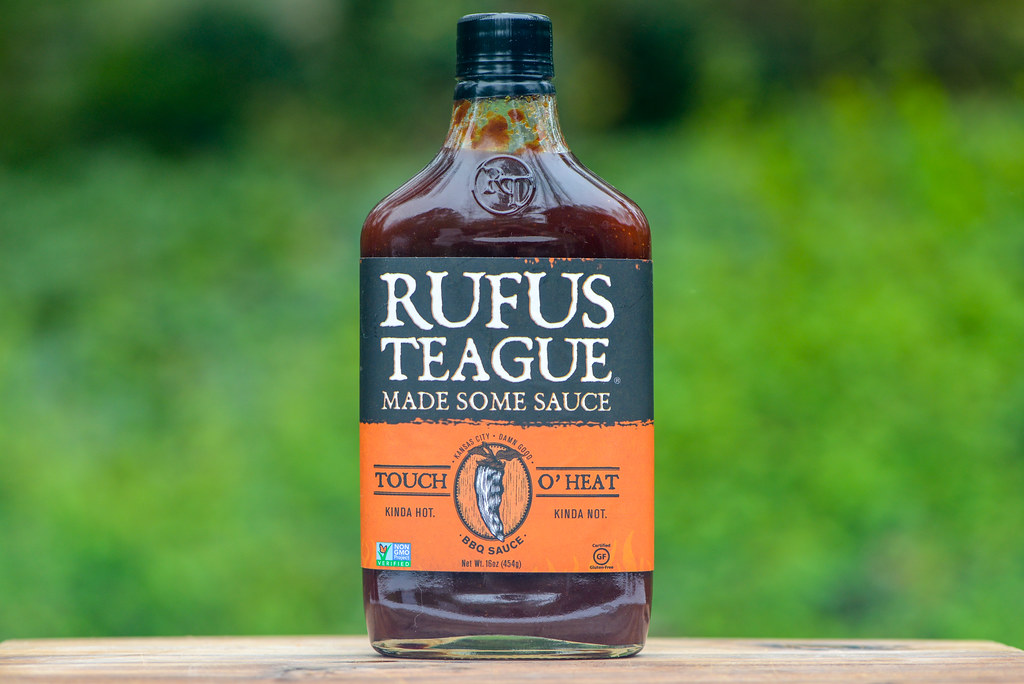Rufus Teague Touch O' Heat Barbecue Sauce

Background
What's one way of standing out in a crowded field or barbecues sauces, especially in a ground zero area like Kansas City—get creative with branding. That's exactly what John McCone, owner of Rufus Teague, did when we first started up just outside of KC in Shawnee, Kansas. See, there never was a Rufus Teague, but a story about an old timer who was a barbecue master and started selling his sauces in leftover whiskey flasks sure sounds good on a bottle. It certainly helps too if, once you're sold on a story, the sauce inside also tastes great, and Rufus Teague has racked up some awards over the years, cementing their sauces deliver on taste as well.
Aroma
A sweet and smoky molasses aroma fills the nose on first whiff of this sauce. While the sugars definitely dominate here, a strong tomato component has a more acidic, tomato paste-like smell rather than a sweet ketchup character. To further the barbecue profile, there is a medium tanginess and earthy heat sl well as a heightened savoriness when compared to your average sauce, possibly the work of soy sauce. Behind the sweetness, there's a hint of heat in there, but it's subtle in the aroma.
Thickness & Texture
This dark maroon sauce has semi-glossy sheen and very slight texture to its otherwise smooth consistancy. It is opaque, which makes it hard to see any spices besides the stray bit of black pepper here and there. The sauce has a thickness that hits right in the middle of the scale, and from a suspended spoon, it first releases in one big drip and then changes to a fast and fairly steady stream. Once most of the sauce has left the silverware, a change to slow drips happens, and after a few of those have occurred, the sauce stops flowing and a medium coating remains on the spoon.
Out of the Jar
The first taste is mostly sweet with a deep tomato flavor. The sugars quickly fade though as the sauce turns very acidic, almost acrid, giving it more of a tomato-paste like flavor. There is good barbecue complexity at play though, with a strong molasses taste, oniony notes, and a medium smokiness. As the sauce sits longer on the tongue, that savoriness that was distinguishable in the aroma works its way in, followed by a lightly spicy and earthy heat. Then, right at the end, both the vinegar and peppers make power plays and drown out any remaining sugars to create a pretty spicy, super tangy, and lightly smoky aftertaste.
Slathered & Cooked
This sauce coated the chicken in a medium, even layer that baked down well over indirect heat. When moved over the coals, there was quick caramelization and only slight burn off. The sugars came more into play after being cooking, making the sauce taste a little less harsh and spicy, although it was still very robust overall with it heavy tomato and acidic character. The best parts were definitely those charred bits which held a little extra sweetness and were very concentrated pockets of flavor.
Put to Use
Longtime readers already know I'm not much a lover of the "bold" barbecue sauce category—these sauces too often having an overpowering flavor that's pushed too far in one direction or another. Rufus Teague Touch O' Heat certainly gets a "bold" label, but there were many workings under the hood that warmed my heart to it. First, in my opinion, it is a bit overly acidic out of the jar, but the strong vinegar and tomato doesn't drown out the savory soy sauce and layers of spices that still come through in spite of upfront tartness. Then, after being cooked, the sauce found better footing with the sugars, making it taste more balanced overall. It was still pretty heavy handed though and masked the natural flavor of the chicken, so if I were to pick up this sauce for my backyard use, it would find a home with heartier meats like ribs, brisket, burgers, and the like.
You Might Also Like
Comments
-
Suzanne Terry Surprised you didn't mention the pronounced flavor of the celery seed. Can't be Kansas City style without that!
-
Tracy Chan Hello,
My friend gave me a jar of Rufus Teague, I can’t find the expiry date on it. May I know if I can use or not? How many years it can usually last?
Thanks,
Tracy




